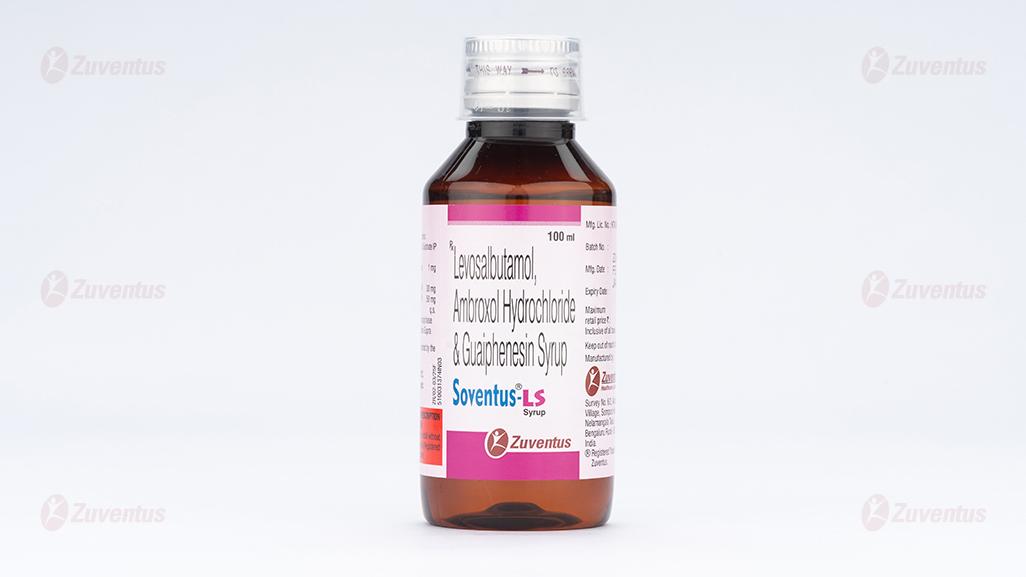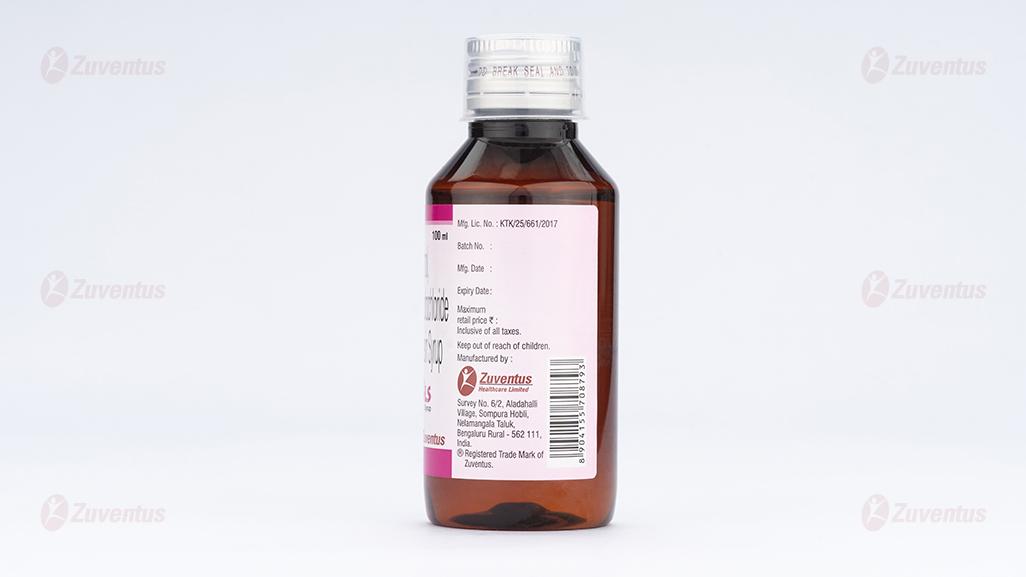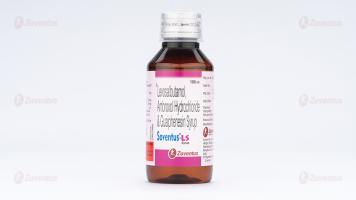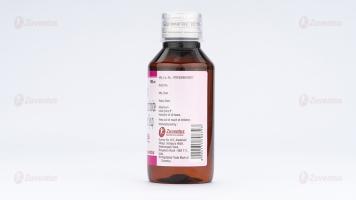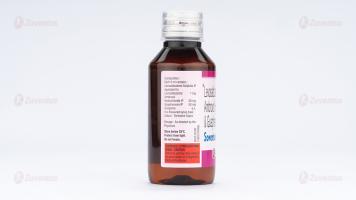Soventus®-LS Syrup
1.0 Generic Name
Levosalbutamol, Ambroxol Hydrochloride & Guaiphenesin Syrup
2.0 Qualitative and quantitative composition
Each 5 ml Contains:
Levosalbutamol sulphate
equivalent to levosalbutamol 1 mg
Ambroxol Hydrochloride BP 30 mg
Guaiphenesin 50 mg
Excipient q. s.
Colour Tartrazine Supra
In a flavoured syrup base
3.0 Dosage form and strength
Syrup
100 ml bottle
4.0 Clinical particulars
4.1 Therapeutic indication
For the symptomatic relief of bronchospasm in bronchial asthma & chronic bronchitis.
4.2 Posology and method of administration
Children between 2 to 6 years: 2.5 ml to be administered 3 times daily.
Children between 6 to 12 years: 5 ml to be administered 3 times daily.
Adults and children above 12 years: 10 ml to be administered 3 times daily.
Soventus®-LS Syrup not be used with other cough and cold medicines. Do not exceed the stated dose. It is recommended to take Soventus®-LS Syrup with food.
4.3 Contraindications
- Hypersensitivity to levosalbutamol, ambroxol, guaiphenesin or to any component of the formulation.
- Cardiac disease, and in patients with significant risk factors for myocardial ischemia.
- Thyrotoxicosis.
4.4 Special warnings and precautions for use
Levosalbutamol
Levosalbutamol, as with all sympathomimetic amines, should be used with caution in patients with cardiovascular disorders, including ischemic heart disease, hypertension, and cardiac arrhythmias; hyperthyroidism; diabetes mellitus; hypersensitivity to sympathomimetic amines; and convulsive disorders.
Significant changes in systolic and diastolic blood pressure have been observed and may be expected to occur in some patients after use of any beta-adrenergic bronchodilators.
Patients with underlying severe heart disease (e.g., ischemic heart disease, arrhythmia or severe heart failure) should be warned to seek medical advice if they experience chest pain or other symptoms of worsening heart disease.
Attention should be paid to assessment of symptoms such as dyspnoea and chest pain, as they may be of either respiratory or cardiac origin. Due to the positive inotropic effects, beta 2-agonists should not be used in patients with hypertrophic cardiomyopathy.
Due to the hyperglycemic effects of β-2-agonists, additional blood glucose controls are recommended initially in diabetic patients. Potentially serious hypokalaemia may result from beta 2-agonist therapy. Particular caution is recommended in acute severe asthma as the associated risk may be augmented by hypoxia. The hypokalemic effect may be potentiated by concomitant treatments. It is recommended that serum potassium levels be monitored in such situations.
Ambroxol Hydrochloride
Ambroxol should be used with caution in patients with gastric ulceration. Care to be taken to avoid contact with eye, skin, serious ingestion or inhalation. In patients with symptoms of chronic impairment of mucus production and/or clearance, ambroxol should be used with caution. In patients with malignant cilia syndrome, the advantages of mucus liquefaction should be carefully weighed against the risk of a secretory obstruction.
The secretolytic effect of ambroxol may be supported by adequate fluid intake. The simultaneous administration of antitussives should definitely be avoided due to the risk of secretory obstruction.
There have been very rare reports of severe skin lesions such as Stevens-Johnson Syndrome and Toxic Epidermal Necrolysis (TEN, Lyell's Syndrome) in temporal association with the administration of mucolytic substances such as ambroxol hydrochloride. Mostly these could be explained by the severity of the underlying disease or concomitant medication. During the early phase of a Stevens-Johnson Syndrome or TEN, a patient may first experience nonspecific influenza-like prodromal symptoms e.g., fever, body ache, rhinitis, cough, and sore throat. If new skin or mucosal lesions occur, treatment with ambroxol hydrochloride should be discontinued as a precaution.
Guaiphenesin
Caution should be exercised in the presence of severe renal or severe hepatic impairment. The concomitant use of cough suppressants is not recommended. Guaiphenesin should not be administered in patients with rare hereditary problems of fructose intolerance. Guaiphenesin is considered to be unsafe in patients with porphyria.
4.5 Drugs interactions
Levosalbutamol
Other Adrenergic Bronchodilator Drugs: Other short-acting sympathomimetic bronchodilators or epinephrine should be used with caution with levosalbutamol. If additional adrenergic drugs are to be administered by any route, they should be used with caution to avoid deleterious cardiovascular effects.
Beta-blockers: Beta-adrenergic receptor blocking agents not only block the pulmonary effect of beta-agonists such as levosalbutamol, but may also produce severe bronchospasm in asthmatic patients.
Diuretics: Diuretics (such as loop or thiazide diuretics) can be acutely worsened by beta-agonists. Hence, caution is advised in the co-administration of beta-agonists with non-potassium sparing diuretics.
Digoxin: Digoxin levels were demonstrated after single-dose intravenous and oral administration of racemic salbutamol, hence it is advisable to carefully evaluate the serum digoxin levels in patients who are currently receiving digoxin and levosalbutamol.
Monoamine Oxidase (MAO) Inhibitors or Tricyclic Antidepressants: Levosalbutamol should be administered with extreme caution to patients being treated with MAO inhibitors or tricyclic antidepressants, or within 2 weeks of discontinuation of such agents, because the action of levosalbutamol on the vascular system may be potentiated.
Ambroxol Hydrochloride
Antibiotics: After using ambroxol, the concentrations of antibiotics such as amoxycillin, cefuroxime, and erythromycin in bronchial secretions and sputum are increased.
Antitussives: Concomitant administration of antitussives may impair the expectoration of liquefied bronchial mucus due to inhibition of the cough reflex and cause accumulation of secretions.
No clinically relevant interactions with other medications have been reported.
Guaiphenesin
Paracetamol: Guaiphenesin may increase the rate of absorption of paracetamol.
Laboratory Tests: If urine is collected within 24 hours of a dose of guaiphenesin, its metabolite may cause a color interference with laboratory determinations of urinary 5-hydroxyindoleacetic acid (5-HIAA) and vanillylmandelic acid (VMA).
4.6 Use in special populations
Pregnant Women
There are no adequate and well-controlled studies of this combination in pregnant women. Transient hypoglycaemia has been reported in new-born preterm infants after maternal beta 2- agonist treatment. Ambroxol crosses the placenta. Animal studies do not show either direct or indirect harmful effects on pregnancy, embryo foetal development, parturition or postnatal development. Comprehensive controlled studies in pregnant women after the 28th week have not shown any harmful effects on the foetus. Use of ambroxol during the first trimester of pregnancy is not recommended. Guaiphenesin has been linked with an increased risk of neural tube defects in a small number of women with febrile illness in the first trimester of pregnancy. Soventus LS syrup should not be used during the first trimester of pregnancy. Caution is advised when Soventus®-LS Syrup is used during second and third trimesters of pregnancy.
Lactating Women
It is not known whether levosalbutamol is excreted in human milk. Although ambroxol is excreted in the breast milk, adverse effects on the infants are unlikely. There is no information regarding effect of guaiphenesin on lactation. Use of Soventus®-LS Syrup is not recommended during lactation. A decision should be made whether to discontinue nursing or to discontinue the drug, taking into account the importance of the drug to the mother.
Paediatric Patients
Safety and efficacy of this formulation in neonates and children below 2 years of age has not been established. Thus, Soventus®-LS Syrup is not recommended for use in paediatric patients below 2 years of age.
Geriatric Patients
Elderly patients with normal renal and hepatic function may be given the same dose as recommended for adults. Levosalbutamol is known to be substantially excreted by the kidney, and the risk of adverse reactions may be greater in patients with impaired renal function. Because elderly patients are more likely to have decreased renal function, care should be taken in dose selection, and it may be useful to monitor renal function.
Renal Impairment Patients
In severe renal impairment, accumulation of ambroxol metabolites has been reported. Therefore, caution should be exercised while using Soventus LS syrup in patients with significant renal dysfunction. Dose should be reduced or the dosing interval must be extended in patients with severe renal impairment.
Hepatic Impairment Patients
In severe hepatic impairment, Soventus LS syrup should be used with caution.
4.7 Effects on ability to drive and use machines
Studies on the effects on the ability to drive and use machines have not been performed with Soventus®-LS Syrup. Ambroxol hydrochloride or guaiphenesin has no or negligible influence on the ability to drive and use machines. In some individuals, levosalbutamol may cause nervousness, headache, dizziness, fatigue and sleeplessness. Thus, caution should be exercised while taking Soventus LS syrup. If affected by dizziness, patients should avoid potentially hazardous tasks such as driving a vehicle or operating machinery.
4.8 Undesirable Effects
Levosalbutamol
The most frequent side effects are palpitation, fine tremors of the skeletal muscle (particularly the hand) and muscle cramps. The other likely side effects are gastrointestinal disturbances such as nausea, vomiting, burning substernal or epigastric pain and diarrhoea. In some cases, nervousness, headache, dizziness, fatigue and sleeplessness may occur. Potentially serious hypokalaemia may result from β 2-agonist therapy. This effect may be potentiated by hypoxia. Particular caution is advised in severe asthma; in such cases, monitoring of serum potassium levels is recommended.
Ambroxol Hydrochloride
Occasional gastrointestinal side effects may occur, but these are normally mild. With prolonged administration in large doses, pain in epigastrium, nausea, vomiting can appear. Additional adverse effects reported rarely with ambroxol include:
Gastrointestinal disorders: Dyspepsia, nausea, vomiting, diarrhoea, and abdominal pain.
Respiratory, mediastinal, and thoracic disorders: Oral and pharyngeal hypoaesthesia, dry mouth, and dry throat.
Nervous system disorders: Dysgeusia (e.g., changed taste).
Immune system disorders: Anaphylactic reactions including anaphylactic shock.
Skin and subcutaneous tissue disorders: Angioedema, rash, urticaria, pruritus, and other hypersensitivity reactions.
Allergic reactions: In patients having hypersensitivity to ambroxol, skin rash, nettle-rash, and angioneurotic oedema may occur.
Guaiphenesin
Side effects resulting from guaiphenesin administration are very rare. Guaiphenesin has occasionally been reported to cause gastrointestinal discomfort, nausea and vomiting, particularly in very high doses. Hypersensitivity reactions may occur. Allergic reactions, angioedema, anaphylactic reactions, dyspnoea (reported in association with other symptoms of hypersensitivity), nausea, vomiting, abdominal discomfort, rash, and urticaria have been reported very rarely with the use of guaiphenesin.
Reporting of suspected adverse reactions
Reporting suspected adverse reactions after authorisation of the medicinal product is important. It allows continued monitoring of the benefit / risk balance of the medicinal product. Healthcare professionals are asked to report any suspected adverse reactions via email to: medico@zuventus.com
Website : http://www.zuventus.co.in/safety.aspx
By reporting side effects, you can help provide more information on the safety of this medicine.
4.9 Overdose
Ambroxol: Symptoms largely correspond with the known adverse effects in case of unintentional overdosing and/or medication errors. Symptomatic treatment is recommended if manifestations of poisoning do occur.
The expected symptoms with overdosage are those of excessive beta-adrenergic stimulation and/or occurrence or exaggeration of any of the side effects, e.g. tachycardia, nervousness, headache, tremor, nausea, dizziness, fatigue, and sleeplessness. Hypokalaemia may also occur. As with all sympathomimetic medications, cardiac arrest and even death may be associated with the abuse of levosalbutamol. Treatment consists of discontinuation of levosalbutamol together with appropriate symptomatic therapy. The judicious use of a cardio-selective beta-receptor blocker may be considered, bearing in mind that such medication can produce bronchospasm. There is insufficient evidence to determine if dialysis is beneficial for overdosage of levosalbutamol.
The effects of acute toxicity from Guaifenesin may include gastrointestinal discomfort, nausea and drowsiness. The drug is, however, rapidly metabolised and excreted in the urine.
Patients should be kept under observation and symptomatic and supportive treatment is advised.
5.0 Pharmacological properties
5.1 Mechanism of Action
Levosalbutamol
Levosalbutamol is a selective beta 2-receptor agonist. Levosalbutamol produces bronchodilation through stimulation of beta 2-adrenergic receptors in bronchial smooth muscles, thereby causing relaxation of bronchial muscle fibres. Activation of beta 2- adrenergic receptors on airway smooth muscle leads to the activation of adenyl cyclase and to an increase in the intracellular concentration of cyclic-3′, 5′-adenosine monophosphate (cyclic AMP). The increase in cyclic AMP is associated with the activation of protein kinase A, which in turn, inhibits the phosphorylation of myosin and lowers intracellular ionic calcium concentrations, resulting in muscle relaxation. Levosalbutamol relaxes the smooth muscles of all airways, from the trachea to the terminal bronchioles.
Levosalbutamol also has a mild anti-inflammatory activity. This is because increased concentration of cyclic AMP is associated with inhibition of the release of inflammatory/bronchoconstrictor mediators from mast cells and eosinophils in the airways.
Ambroxol Hydrochloride
Ambroxol causes an increase of secretion in the respiratory tract. It enhances pulmonary surfactant production and stimulates ciliary activity. These actions result in improved mucus flow and transport (mucociliary clearance). Improvement of mucociliary clearance has been shown in clinical pharmacologic studies. Enhancement of fluid secretion and mucociliary clearance facilitates expectoration and reduces cough.
Guaiphenesin
Guaiphenesin is thought to exert its expectorant action by stimulating receptors in the gastric mucosa. This increases the output from secretory glands of the gastrointestinal system and increases the flow of fluids from glands lining the respiratory tract. The result is an increase in volume and decrease in viscosity of bronchial secretions. Another possible mechanism by which it acts is by increasing the water bonding in the sputum, thereby decreasing its viscosity and leading to an increase in mucokinesis.
Other actions may include stimulation of vagal nerve endings in bronchial secretory glands and stimulating certain centers in the brain, which in turn enhance respiratory fluid flow.
5.2 Pharmacodynamic properties
Levosalbutamol
Levosalbutamol, the (R)-enantiomer of salbutamol, is a selective beta 2-receptor agonist. Levosalbutamol has approximately 2-fold greater affinity than racemic salbutamol for the beta 2-adrenergic receptor and approximately 100-fold greater affinity than S-salbutamol. Levosalbutamol is a single isomer beta 2-agonist that differs from racemic salbutamol by elimination of (S)-salbutamol. Levosalbutamol is an effective bronchodilator whose primary mechanism of action is unimpeded by (S)-salbutamol. Therefore, when compared with racemic salbutamol, clinically comparable bronchodilation can be achieved with lesser doses of levosalbutamol. Further, levosalbutamol also substantially decreases beta-mediated side effects associated with racemic salbutamol.
Levosalbutamol has bronchodilator, bronchoprotective, anti-inflammatory, and anti-edematous properties.
Ambroxol Hydrochloride
Ambroxol is the active metabolite of bromhexine. Ambroxol is more effective than bromhexine and is non-toxic and well tolerated. Ambroxol possesses mucolytic, mucokinetic (improvement in mucus transport), and secretolytic properties. It promotes the removal of tenacious secretions from the respiratory tract and reduces mucus stasis (arresting the secretion of mucus). Ambroxol also exhibits anti-oxidant activity.
Guaiphenesin
Guaiphenesin produces its expectorant action by increasing the volume of respiratory tract fluid and reducing the viscosity of tenacious secretions.
5.3 Pharmacokinetic properties
Levosalbutamol
Levosalbutamol [(R)-salbutamol] appears to be stereochemically stable in vivo and does not appear to interconvert metabolically to (S)-salbutamol.
Absorption: Whether administered alone or as the racemate, salbutamol enantiomers are well absorbed from the gastrointestinal tract and have time to maximum drug concentration (Tmax) values ranging from 45 to 360 minutes. The bioavailability of levosalbutamol increases from 9% after a single oral dose to 30% at steady state.
Distribution: The blood to plasma ratio for total salbutamol appears to be near unity (0.96 ± 0.13) in healthy volunteers, suggesting that the total blood clearance of salbutamol is equal to the total plasma clearance once steady state has been reached. Values for binding to blood components, along with similar volumes of distribution for salbutamol enantiomers, suggest that protein binding plays a relatively minor role in the disposition of salbutamol enantiomers.
Metabolism: The intestine is the main site of enantio-selective presystemic metabolism of salbutamol for drug absorbed in the gastrointestinal tract. The clearance of salbutamol by the human body is to a major extent is dependent on sulphate conjugation, in particular after oral dosing. Racemic salbutamol is metabolized by sulphotranferase 1A3 (SULT1A3) to an inactive metabolite in human tissues. However, (R)-salbutamol (levosalbutamol) is sulphated 8-fold faster than (S)-salbutamol because of its higher binding affinity for the enzyme.
Elimination: Calculated renal clearance values for both enantiomers were significantly larger than creatinine clearance, indicating active renal excretion. This leads to relatively higher concentrations of the drug in urine than in plasma.
Ambroxol Hydrochloride
Ambroxol is absorbed rapidly and almost completely after oral administration. Oral bioavailability is approximately 60% owing to the first-pass effect. Bioavailability of ambroxol hydrochloride is not affected by food. Plasma concentrations are in a linear relationship to the dose. Peak plasma levels are attained after 0.5 to 3 hours. Plasma protein binding is around 90% in the therapeutic range. After oral, intravenous, and intramuscular administration, ambroxol is distributed swiftly and extensively from the blood into the tissues. The highest active ingredient concentrations have been measured in the lung.
Ambroxol is metabolized in the liver mainly by conjugation. Studies in human liver microsomes showed that CYP3A4 is the predominant isoform for ambroxol metabolism. Around 30% of an oral dose is eliminated via the first-pass effect. The terminal half-life is about 10 hours. Total clearance is 660 ml/min approximately, and renal clearance is 8% of the total clearance.
Guaiphenesin
Guaiphenesin is well absorbed from the gastrointestinal tract following oral administration. However, limited information is available regarding its pharmacokinetics. After the administration of 600 mg guaiphenesin to healthy adult volunteers, the Cmax was approximately 1.4 mcg/ml, Tmax occurred approximately 15 minutes after drug administration, t½ was approximately 1 hour and the drug was not detectable in the blood after approximately 8 hours. Guaiphenesin appears to undergo both oxidation and demethylation.
6.0 Nonclinical Properties
6.1 Animal Toxicology or Pharmacology
Levosalbutamol
Carcinogenicity: Although there have been no carcinogenesis studies with levosalbutamol, racemic salbutamol Sulphate has been evaluated for its carcinogenic potential. In a 2-year study in Sprague-Dawley rats, dietary administration of racemic salbutamol Sulphate resulted in a significant dose-related increase in the incidence of benign leiomyomas of the mesovarium at doses of 2 mg/kg/day and greater. In an 18- month study in CD-1 mice and a 22-month study in the golden hamster, dietary administration of racemic salbutamol Sulphate showed no evidence of tumorigenicity. Dietary doses in CD-1 mice were up to 500 mg/kg/day and doses
in the golden hamster study were up to 50 mg/kg/day. Mutagenesis: Levosalbutamol HCl was not mutagenic in the Ames test or the CHO/HPRT Mammalian Forward Gene Mutation Assay. Levosalbutamol was not clastogenic in the in vivo micronucleus test in mouse bone marrow. Racemic salbutamol Sulphate was not clastogenic in an in vitro chromosomal aberration assay in CHO cell cultures. Impairment of Fertility: No fertility studies have been conducted with levosalbutamol. Reproduction studies in rats using racemic salbutamol sulphate demonstrated no evidence of impaired fertility at oral doses up to 50 mg/kg/day. Teratogenicity: In animal studies, oral administration of levosalbutamol HCl to regnant New Zealand White rabbits found no evidence of teratogenicity at doses up to 25 mg/kg/day. However, other studies demonstrated that racemic salbutamol Sulphate was teratogenic in mice and rabbits at doses comparable to the human therapeutic range. Pregnant mice administered racemic salbutamol Sulphate subcutaneously (s.c.) had a dose-related increased incidence of cleft palate in their fetuses. The drug did not induce cleft palate formation when administered subcutaneously at a dose of 0.025 mg/ kg/day. In addition, oral administration of racemic salbutamol Sulphate to pregnant rabbits resulted in an increased incidence of cranioschisis in foetuses.
Ambroxol Hydrochloride
Toxicity: Ambroxol hydrochloride has a low index for acute toxicity. In repeat-dose studies, oral doses of 150 mg/kg/day (mouse, 4 weeks), 50 mg/kg/day (rat, 52 and 78 weeks), 40 mg/kg/day (rabbit, 26 weeks) and 10 mg/kg/day (dog, 52 weeks) were the no-observed adverse effect level (NOAEL). No toxicological target organs were detected. Four-week intravenous toxicity studies with ambroxol hydrochloride in rats (4, 16 and 64 mg/kg/day) and in dogs (45, 90 and 120 mg/kg/day (infusion 3 h/day)) showed no severe local and systemic toxicity including histopathology. All adverse effects were reversible. At 500 mg/kg/day, ambroxol hydrochloride was slightly toxic for dams and pups, as shown by a retarded body-weight development and reduced litter size.
Carcinogenicity: Ambroxol hydrochloride did not show any tumorigenic potential in carcinogenicity studies in mice (50, 200 and 800 mg/kg/day) and rats (65, 250 and 1000 mg/kg/day) when treated with a dietary admixture for 105 and 116 weeks, respectively. Mutagenesis: Genotoxicity studies in vitro (Ames and chromosome aberration test) and in vivo (mouse micronucleus test) did not reveal any mutagenic potential of ambroxol hydrochloride.
Impairment of Fertility: The fertility of male and female rats was not affected up to 500 mg/kg/day. The NOAEL in the peri- and post-natal development study was 50 mg/kg/day. Teratogenicity: Ambroxol hydrochloride was neither embryotoxic nor teratogenic when tested at oral doses up to 3000 mg/kg/day in rats and up to 200 mg/kg/day in rabbits.
Guaiphenesin
There is no relevant information available.
7.0 Description
Each 5 ml of Soventus LS syrup contain 1 mg of levosalbutamol, 30 mg of ambroxol hydrochloride, and 50 mg of guaiphenesin for oral administration. Levosalbutamol Levosalbutamol, also called as levalbuterol, is a short-acting β2 adrenergic receptor agonist used as a bronchodilator.
Molecular Weight: 337.39 g/mol. Molecular Formula: C13H23NO7S. Chemical Name: 4-[(1R)-2-(tert-butylamino)-1-hydroxyethyl]-2-(hydroxymethyl)phenol; sulfuric acid.
Ambroxol Hydrochloride
Ambroxol hydrochloride is a metabolite of bromhexine that stimulates mucociliary action and clears the air passages in the respiratory tract. Molecular Weight: 414.56 g/mol. Molecular Formula: C13H19Br2ClN2O. Chemical Name: 4-[(2-amino-3,5-dibromophenyl)methylamino]cyclohexan-1 ol; hydrochloride.
Guaiphenesin
Guaiphenesin, also called as Guaiphenesin or glyceryl guaiacolate, is an expectorant which promotes or facilitates the removal of secretions from the respiratory tract. Guaiphenesin is a white or slightly gray crystalline substance with a slightly bitter aromatic taste. Molecular Weight: 198.21 g/mol. Molecular Formula: C10H14O4. Chemical Name: 3-(2-methoxyphenoxy)-1,2-propanediol.
8.0 Pharmaceutical particulars
8.1 Incompatibilities
Not Applicable
8.2 Shelf life
Refer on Pack
8.3 Storage and handling information
Store below 25°C.
Protect from light.
Do not freeze.
Read all of this leaflet carefully before you start taking this medicine because it contains important information for you.
- Keep this leaflet. You may need to read it again.
- If you have any further questions, ask your doctor or pharmacist.
- This medicine has been prescribed for you only. Do not pass it on to others. It may harm them, even if their signs of illness are the same as yours.
- If you get any side effects, talk to your doctor or pharmacist. This includes any possible side effects not listed in this leaflet.
What is in this leaflet:
1. What Soventus®-LS Syrup is and what it is used for
2. What you need to know before you take Soventus®-LS Syrup
3. How to take Soventus®-LS Syrup
4. Possible side effects
5. How to store Soventus®-LS Syrup
6. Contents of the pack and other Information
1. What is Soventus®-LS Syrup and what it is used for
Soventus®-LS Syrup is the combination of Levosalbutamol, Ambroxol Hydrochloride & Guaiphenesin Syrup. These active ingredients belong to a group of medicines known as bronchodilators, mucolytic and mucokinetic used to treat asthma, bronchospasm and reversible airways obstruction by widening the airways of the lungs. It is suitable for children or adults who prefer liquid medicines or are unable to use an inhaler device.
Ambroxol hydrochloride widely used as a mucolytic. It increases secretion in the respiratory tract and stimulates ciliary activity. These actions result in improved mucus flow and clearance. Enhancement of fluid secretion and mucociliary clearance facilitates expectoration and reduces cough. Levosalbutamol is used as a bronchodilator, used to treat bronchospasm and symptoms of asthma and chronic obstructive pulmonary disease (COPD), such as coughing, wheezing, and shortness of breath. It relaxes the muscles in the airways and increases airflow to the lungs. Levosalbutamol makes breathing easier by widening the airways. By bronchodilator action, it also increases mucociliary clearance, suppression of oedema and exerts anti- allergic effects. Guaifenesin is an expectorant that also has some muscle relaxing action. It is used in many cough preparations. This increases the flow of fluids from glands lining the respiratory tract. This results in an increase in volume and decrease in viscosity of bronchial secretions.
2. What you need to know before you take Soventus®-LS Syrup
Do not take Soventus®-LS Syrup if you:
- Hypersensitivity to any of the components of the formulation.
- Pre-existing ischaemic heart disease or those patients with significant risk factors for ischaemic heart disease.
- Gastric ulceration.
Warnings and precautions
In cases of severe renal failure, an accumulation of metabolites formed in the liver must be considered, and a reduction in the maintenance dose of Ambroxol or an increase in the dose interval must be performed. In patients with a tendency for peptic ulcers, the use of Ambroxol hydrochloride should be carefully considered.
For Levosalbutamol, caution should be observed in patients with thyrotoxicosis. Cardiovascular effects may be seen with sympathomimetic drugs, including Levosalbutamol.
Guaifenesin should not be used for persistent or chronic cough, such as occurs with asthma, or where cough is accompanied by excessive secretions, unless directed by a physician. Caution should be exercised in the presence of severe renal or severe hepatic impairment. The concomitant use of cough suppressants is not recommended.
Other medicines and Soventus®-LS Syrup
The concomitant use of antitussives along with ambroxol may impair the coughing up of the liquefied bronchial mucous and cause a secretory obstruction.
The administration of ambroxol with antibiotics (amoxicillin, cefuroxime, and erythromycin) increases the concentration of antibiotics in bronchopulmonary secretions and sputum.
Levosalbutamol and non-selective β-blockers should not be administered concurrently. Levosalbutamol should be used with caution in patients receiving other sympathomimetic.
Levosalbutamol should be administered with extreme caution to patients being treated with monoamine oxidase inhibitors or tricyclic antidepressants, or within 2 weeks of discontinuation of these agents, since the action of Levosalbutamol on the vascular system may be potentiated.
Soventus®-LS Syrup with food and drink
It is recommended to take Soventus®-LS Syrup with food.
Use in Special Population:
Pregnancy
Since there are no adequate and well-controlled studies of this combination in pregnant women, this medicine should be administered with caution.
Lactation
Levosalbutamol is secreted into breast milk, but any effect on the infant is unlikely at therapeutic doses. Transient hypoglycaemia has been reported in new-born preterm infants after maternal β-2 agonist treatment. Since Guaifenesin is excreted in breast milk in small amounts, decision must be made to continue with the medicine if benefit of drug outweighs the risks of treatment.
Geriatric Population
They are more sensitive to the effects of Levosalbutamol; hence a lower dose may be required.
Pediatric population
Not recommended for children below 2 years of age.
Hepatic & Renal Insufficiency
Caution should be exercised in patients with moderate to severe renal impairment and liver disease.
Effects on ability to drive and use machine
Patients should be cautioned against engaging in activities requiring complete mental alertness, and motor coordination such as operating machinery until their response to Soventus syrup is known.
3. How to take Soventus®-LS Syrup
Always take Soventus syrup exactly as your doctor has told you. You should check with your doctor or pharmacist if you are not sure.
Taking this medicine
- Take this medicine by mouth.
- If you feel that this medicine is too weak or too strong, do not change the dose yourself, but ask your doctor.
How much to take
Children between 2 to 6 years: 2.5 ml to be administered 3 times daily.
Children between 6 to 12 years: 5 ml to be administered 3 times daily.
Adults and children above 12 years: 10 ml to be administered 3 times daily.
If you take more Soventus®-LS Syrup than you should
If you take more Soventus syrup than you should, tell a doctor or go to a hospital casualty department straight away. Take the medicine pack with you. This is so the doctor knows what you have taken.
If you forget to take Soventus®-LS Syrup
If you forget a dose, do not worry. Just wait until the next dose is due. Do not take a double dose to make up for a forgotten dose.
4. Possible Side Effects
The most common adverse reactions with Ambroxol are nausea, oral and pharyngeal hypoesthesia, dyspepsia, dry mouth, abdominal pain and allergic reactions such as skin rash or urticaria can also occur.
Tremor and headache are the most common adverse events observed with Levosalbutamol administration. Tachycardia, palpitations, muscle spasms and hypokalaemia are few other common adverse reactions observed.
Guaifenesin has occasionally been reported to cause gastro-intestinal discomfort, nausea and vomiting, particularly in very high doses. Allergic reactions, angioedema, anaphylactic reactions, dyspnoea (reported in association with other symptoms of hypersensitivity), nausea, vomiting, abdominal discomfort, rash and urticaria may also occur.
Reporting of side effects
If you get any side effects, talk to your doctor. This includes any possible side effects not listed in this leaflet. You can also report side effects directly: Website: www.zuventus.co.in and click the tab “Safety Reporting” located on the top of the home page.
By reporting side effects, you can help provide more information on the safety of this medicine.
5. How to store Soventus®-LS Syrup
- Store below 250C, protected from light & moisture.
- Do not throw away any medicines via wastewater or household waste. Ask your pharmacist how to throw away medicines you no longer use. These measures will help protect the environment.
- Keep away from the reach of children. Do not freeze.
6. Contents of the pack and other information
What Soventus®-LS Syrup contains:
Each 5 ml Contains:
Levosalbutamol sulphate
equivalent to levosalbutamol IP 1 mg
Ambroxol Hydrochloride IP 30 mg
Guaiphenesin IP 50 mg
Excipients q. s.
1x100ml, PET Bottle

